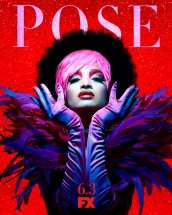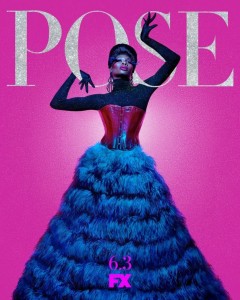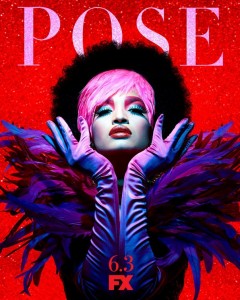The new Sunday-night FX Networks series POSE, created by Ryan Murphy & Brad Falchuk & Steven Canals, is set in the 1980s New York underground ballroom scene. These balls are dance and dress competitions for transgender and gay people, many of them people of color. Some have been rejected by their birth families and find new kin in the “houses” that comprise the ballroom world. While POSE is a scripted drama, the ballroom world is real – chronicled in Jennie Livingston’s influential 1990 documentary PARIS IS BURNING, it continues to this day and has become a global phenomenon.
Much of the cast and staff of POSE is LGBTQ (including Murphy and Canals). Transgender activist and author (REDEFINING REALNESS) Janet Mock, a producer, director, and writer on POSE, talks about why she thinks this is a good moment for a series like POSE to air, and much more.
ASSIGNMENT X: Do you think that the success of TRANSPARENT, which is about a transgender woman, had anything at all to do with FX agreeing to make POSE, or do you think that Ryan Murphy as a producer has enough power at this point to do whatever he wants?
JANET MOCK: I think it’s a mix of that. I think, of course, we’re building upon the cultural moment that paved the way through Laverne Cox’s award-nominated work on ORANGE IS THE NEW BLACK, and of course, what Jill Soloway has done in creating opportunities for trans talent on TRANSPARENT, I think it made the road a little easier to pave, but I think that at the same time, largely, we’re assembling a cast of not only trans people, but also, people of color. And so oftentimes, you need someone who has institutional power, and a track record like a Ryan Murphy, to be able to green-light something like that, to have millions of dollars be invested in a show, in a series, to tell this story. It is a collective work. And I think it’s the activism that’s out there, I think it’s the time period, I think it’s all these things together have created this point where I think someone like an FX can say, “Yeah, let’s green-light this and see what it’s going to be.”
AX: You have written some memoirs. Had you been looking to work in the dramatic form and narrative television?
MOCK: I had, yeah. Me and Ryan were both repped by the same agency, and so when they brought us together, he was actually shooting VERSACE [THE ASSASSINATION OF GIANNI VERSACE: AMERICAN CRIME STORY, another FX series]. And so I went to [the set to see] one of the scenes with Cunanan [played by Darren Criss] and Versace [played by Gael Garcia Bernal], and it was interesting to watch Ryan work, and then have a deep conversation about the next thing he wanted to invest his time in, and his legacy. And he talked about legacy-building in the sense of, bringing other people in that he could help develop, not just actors in front of the screen, but writers, and so the fact that I didn’t have a TV writing credit didn’t really scare him. He was like, “I know you can write, so let’s just give you the chance to do that.”
AX: How do you balance being true to the LGBTQ world of the period with educating people who have no idea about it, without overloading POSE with exposition? Your job isn’t actually to educate people …
MOCK: But in the writers’ room, it is. It’s an unlearning of all the things I’ve learned through being a public figure, where it’s like, “I’m not taking a question, I’m not answering that, go to Google.” The writers’ room is a very sacred and intimate space, and so no question is off-limits. So there’s a stripping away of ego for all of us. We’re on the same level, because we all have “writer” as our credit. So when you’re in the writers’ room, [Murphy doesn’t] come in as, “I’m Ryan Murphy, and I’m here to tell you what you’re going to write,” it’s, “We’re going to come together, and write what we want to write together, but have to have a conversation first.” And so there were a lot of conversations about blackness, about colorism, about hair textures – that’s why you see the girls with all the naturals [laughs] – all of this stuff, all of that was really thought through, and it was through the conversations that we had about what it means to be a person of color, but then a person of color in the ‘80s, who’s a woman, who’s also a trans woman, who’s also poor.
All that stuff comes in, and so you have to break it down to the very basic elements of it, and then not make it to conscious in the point of, “We’re in the 2000s, writing about the 1980s,” but really, what was it like to live at that time, and to be young and trans and poor and a person of color? And having to distill that down to my collaborators was a lot of the labor that I had to do in the room, that then shows up in a really powerful way. So when I say, “Why is her hair straight? Shouldn’t we have someone with a Jheri curl?” Then that’s like, “Oh, that’s right. We should probably think about diversity of texture in hair in this time period.” [laughs] So it’s all those little things that show up, and those conversations show up in bigger ways.
AX: How did you in the writers’ room foster that trust? Did it come immediately?
MOCK: Oh, God, no. Number One, I didn’t want a job where I had to go to an office every day. That was my biggest thing, that I had to deal with people [laughs]. I was fine with dealing with people on the Internet, or having to deal with an editor that’s not in my space. When you have to go to a space that’s a shared space, you’re getting to know one another, you’re building trust, you’re building intimacy, because Ryan really created a safe room. “In this room, nothing comes out of this room. What comes out of this room will end up on the page.” And so when he said that, that it was about serving these women and these characters, for me, I was able to be open. And we had some tough fights. We had fights about breaking down your own privilege, Activism 101 stuff that you have to have, and consciousness-raising. Really, that room was a consciousness-raising exercise, so that it could better serve the story. And so for me, how I dealt with it was, I had to recognize there early on that this was part of the labor that I had to do.
And I also wasn’t alone. [POSE co-creator] Steven – Bronx, Afro-Latino, grew up in the projects – I had a co-conspirator there. And also having Brad Falchuk, who was so open. He was a sponge. He just wanted to get the story right. And then Ryan – Ryan was Ryan. Sometimes he’d be like, “You know, but is it really that way?” And I’m like, “You’ve got to believe me. I’m the expert on this experience.” It’s like, you’re the expert on TV, I’m the expert on this particular experience. And that’s what we built. Also, there was a great bonding experience that happened with the two months of being in New York and shooting the first two episodes. We just finished doing that. And so we’re all incredibly meshed together. The cast, the crew, the hair and makeup people, the consultants from the Ballroom, all of that stuff, after shooting, doing it and seeing it, and seeing how the rough cuts grow together, you’re like, “Oh, this is why we did the work in the way that we did it.” But because of Ryan, too, his power, the institutional power that he’s built as a white gay man in this space, in this industry, to be this golden boy for an entire network. Only he could green-light something like this [laughs]. People have tried to do ballroom shows, and they’ve never happened.
AX: With the casting, were there any people where you thought they were right for roles and they could act, but you needed to teach them to dance, or they could dance, but you needed to teach them to act?
MOCK: There are a couple of recurring characters who were more just dancers. They don’t really act. They’re kind of there, they pepper the scenes and pepper the House of Abundance, which is Elektra’s, or Dominique [Jackson]’s character’s House. But all of our actors – it’s funny, we have a lot of singers. We have a lot of people who can sing, so I’m trying to picture our musical episode [laughs]. We have choreographers from the scene, actually – Naomi Maldonado, who was recently in a Nike commercial, she’s a legendary Vogue-er. She’s one of our choreographers on the show. And Danielle Piscano, who just choreographed the Bruno Mars/Cardi B remix “Finesse.” She’s in it. All our people are doing all this stuff, and so we have great choreographers who know how to make people who may not know how to Vogue, which is very specific. Everyone knows how to dance, but to teach people how to Vogue is something very, very specific.
AX: I think you were probably alive in the ‘80s –
MOCK: As a baby –
AX: But did you know anything about the Ballroom scene in the ‘80s, or were you too young for that?
MOCK: I knew it from PARIS IS BURNING. I saw PARIS IS BURNING I think when I was in high school. The name of my first book is REDEFINING REALNESS. It comes from viewing PARIS IS BURNING, from the Ballroom. “Realness” comes out of that as a term. So for me, it has always been a seminal piece of my own understanding of my sisters, who did not grow up in Hawaii like I did, but who grew up in New York City in a poor community – my community was poor, too, but it just was different, to grow up in New York City.
AX: What would you most like people to know about POSE?
MOCK: What would I like people to know about POSE? [laughs] Feel your way through it. Though it may not look like it’s for you, it’s for you.
This interview was conducted during FX Networks’s portion of the Television Critics Association (TCA) press tour.
Follow us on Twitter at ASSIGNMENT X
Like us on Facebook at ASSIGNMENT X
Article Source: Assignment X
Article: POSE: Exclusive Interview with POSE writer-producer-director Janet Mock
Related Posts:













